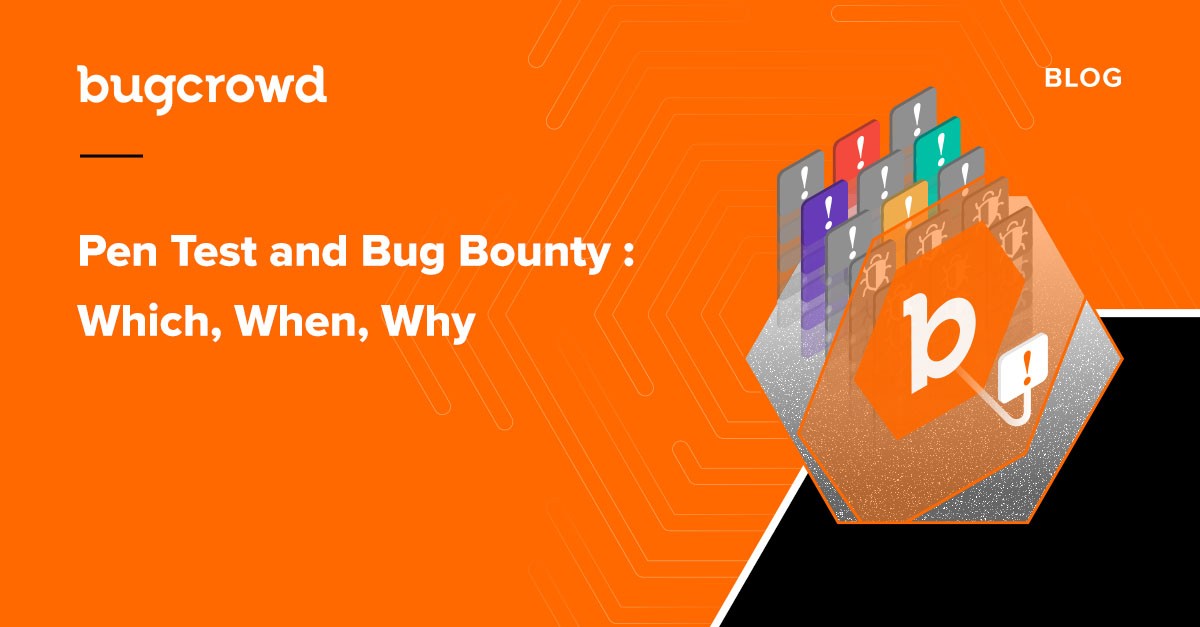Cybersecurity risk management has changed dramatically in recent years. The ability to demonstrate maturity through reactive measures like detection and monitoring, identity management, and incident response used to be the main goal for most organizations. Now, proactive risk reduction strategies like pen testing (invented decades ago but now in a renaissance) and bug bounty often complement those maturity processes. Why? Because threats are now so ingenious and dynamic that focusing on defense all the time feels like rowing against the tide in a very leaky boat.
At Bugcrowd, we’ve found that among security teams that have made/are making the reactive/proactive shift, the definition of “pen testing” and what it involves can vary. And when you add bug bounty to the conversation, requirements discovery becomes even more interesting. For some customers, pen testing and bug bounty are even interchangeable terms.
In this post, we’ll offer our views about how pen testing and bug bounty compare, and why they’re often deeply complementary.
Understanding pen testing and bug bounty programs
Pen testing and bug bounty programs are both key pillars in an organization’s offensive security strategy. However, they can be tricky to define. Here is a breakdown of both testing methods.
What is penetration testing?
Per NIST, penetration testing is a technique “where testers target individual binary components or the application as a whole to determine whether intra- or inter-component vulnerabilities can be exploited to compromise the application, its data, or its environment resources.” But, even that lengthy definition is vague. Pen testing is a simulated cyberattack carried out by an authorized third party (known as pen testers) who tests and evaluates the security vulnerabilities of a target organization’s computer systems, networks, and application infrastructure.
Pen tests have three defining characteristics:
- Typically time bound
- Follow a testing methodology
- Always done privately
Many customers also expect a final report for demonstration of regulatory compliance to an auditor.
Pen testing has several benefits, including:
- Identifying vulnerabilities: By conducting penetration tests, organizations can identify vulnerabilities and weaknesses in their systems or networks that could be exploited by hackers.
- Evaluating security controls: Penetration testing allows organizations to evaluate the effectiveness of their existing security controls and identify areas for improvement.
- Mitigating risks: By addressing vulnerabilities identified during penetration testing, organizations can reduce the risk of potential security breaches and unauthorized access.
- Compliance requirements: Many industries have regulatory requirements that mandate regular penetration testing to ensure the security of sensitive data.
What are bug bounty programs?
Bug bounty was invented in the 1990s to help address the cybersecurity talent gap and to level the playing field between defenders and attackers. The premise was to engage with the global ethical hacker community to help you find vulnerabilities like only hackers can, and at scale. It also overlaid an ingenious “pay for results” economic model that uses gamification to incentivize impactful results: the more critical the vulnerability, the higher the reward. In 2012, Bugcrowd pioneered the idea of an intermediating software platform to that concept, making both bug bounty programs and crowdsourced security accessible to the broader market.
Some of the benefits of bug bounty programs are:
- Lower cost per vulnerability discovered compared to other security solutions.
- An opportunity to engage a diverse group of hackers with a broad array of skillsets that you make not already have on your internal team.
- A way to help organizations stay on top of the always-evolving landscape of security threats. Just like threat actors, the hackers who bug hunt on the Bugcrowd Platform focus on continuous improvement and perpetual learning, keeping you on the edge of the next “big threat.”
- A cost-effective way to discover vulnerabilities and triage risks that internal security teams may miss.
- A way to build up the reputation of an organization amoung hackers and the broader security community as a place that takes security seriously.
- They provide continuous assurance that allows you to maintain the highest standard of security for critical assets.
- They provide better line-of-sight into security ROI than traditional approaches by directly aligning costs with vulnerabilities based on their impact.
Key differences between pen testing and bug bounty programs
Pen testing and bug bounty engagements have similar goals, but can have different levels of intensity of the assessment. Pen tests are fit for checklist-driven discovery of common vulnerabilities. They are methodology-driven, pay for effort, point in time, and is run by 1-3 people. Think of pen tests as a great way to find the “low hanging fruit” common vulnerabilities.
Bug bounty engagements cover finding hidden flaws that pen tests might miss. They leverage ongoing discovery of emerging or hidden vulnerabilities with a freestyle approach, they are pay for impact, they can be continuous or point in time, they include hundreds of bug hunters, and their main use case is risk reduction.
To help differentiate them, here is a quick table comparing options:

Pen testing and its use cases
Pen testings main use case is compliance with internal and/or external controls. After a pen test, a report will be provided. Reports are often done with respect to compliance requirements to meet the needs of ISO 27001, SOC2 Type 2, PCI, HITRUST, FISMA, and other compliance regulations. These pen testing reports can often support risk assessments, such as those required to ensure HIPAA compliance.
Although many buyers take a standard approach to pen testing, with few variations across organizations, some have special requirements around pentester skill sets and/or location, pen test targets, duration, and methodology. And of course, there are numerous examples of large organizations that run every kind of pen test under the sun at one time or another. So where does bug bounty fit in this picture?
Bug bounty and its use cases
Although some characterize bug bounty as simply an “open-scope vulnerability disclosure program” with cash rewards attached to it, we take a different view with customers. Like pen testing, bug bounty is in fact a focused, strategic approach to discovery and assessment of security risk. Bug bounty programs are appropriate for organizations who:
- Want to take a “pay for impact” approach to incentivize the discovery of high-impact vulnerabilities without a predetermined checklist or methodology
- Are looking for a wide range of hackers to apply their skills and experience to the problem to find novel vulnerabilities and fixes
- Want 24/7 coverage of assets
Factors to consider in deciding between pen testing and bug bounty programs
Many customers conflate bug bounty and pen testing because they both rely on attacker tools, techniques, and mindset for vulnerability discovery under a predefined scope, which is certainly accurate. Beyond the tactical execution details (use of a methodology versus no methodology, report versus no report, etc.), you have to squint a bit to see the differences. Ultimately, pen testing and bug bounty have very similar goals but differ with respect to the intensity of the assessment. With this in mind, one can easily envision a layered strategy for both compliance and risk reduction that combines:
- Ongoing vulnerability discovery and assessment–when exploitability of vulnerabilities is confirmed, this is what some might consider a “basic” pen test
- Periodic, human-driven pen testing to find common flaws that (1) may have missed (what some might consider a “standard” pen test)
- A continuous bug bounty running “over the top” to pick up emerging vulnerabilities not yet reflected in the methodologies used in (1) and (2)
The average Bugcrowd customer who combines pen testing and bug bounty programs finds 3-5x more high-impact vulnerabilities versus standard pen testing alone, which greatly reduces the cost per vulnerability. With this understanding, it’s easy to see that point-in-time pen testing and continuous bug bounty are highly complementary. And that’s where the Bugcrowd Platform plays a unique role.
Platform-powered Pen Testing as a Service (PTaaS)
Pen testing was invented in the 1970s, and it shows. Many external providers still approach pen testing as a consulting engagement, which leads to delays, noise, added cost, and low-impact results for use cases that go beyond compliance checkboxes. For internal pen testing teams, finding the right talent to achieve even minimal goals can be very difficult. In either case, pen tests have always been done in silos, with findings often disappearing into a black hole.
Penetration Testing as a Service (PTaaS) is an incremental improvement designed to address some of these problems. The benefits of using a SaaS platform for pen testing are pretty clear–faster onboarding, 24/7 reporting, integration with the SDLC, and so on–but there is so much more that can be done. For example, what if you could:
- Meet your precise compliance/risk reduction goals–ranging from basic assurance to maximum, continuous risk reduction? (See our announcement about expanding the Bugcrowd suite of PTaaS offerings to address multiple pen test use cases.)
- Integrate pen testing, bug bounty, vulnerability disclosure, and even attack surface management on a single platform with a unified user experience (not in silos)?
- Share data about vulnerabilities, assets, and environments across all of them via a multi-solution platform that brings contextual, risk reduction intelligence into every workflow?
- Integrate highly curated crowds into pen tests when needed (just like bug bounty), so that the right experts are precisely matched and activated for your needs at the right times, and there are always lots of eyes on your targets (which can be easily rotated as needed)?
With the Bugcrowd approach to PTaaS, you can. Unlike consultancies or purpose-built solutions for PTaaS or bug bounty, Bugcrowd’s multi-solution platform allows you to run multiple crowdsourced security solutions in parallel, with everything taking advantage of automated workflows, the ability to bring the right crowd into those use cases at the right times, and a shared knowledge base of vulnerability, asset, environment, and hacker skill set data adding contextual insights and advice to everything that happens in the platform. That’s what “PTaaS done right” means!
To learn more about Bugcrowd’s modern approach to pen testing, download our “See Security Differently: PTaaS Done Right” ebook.



